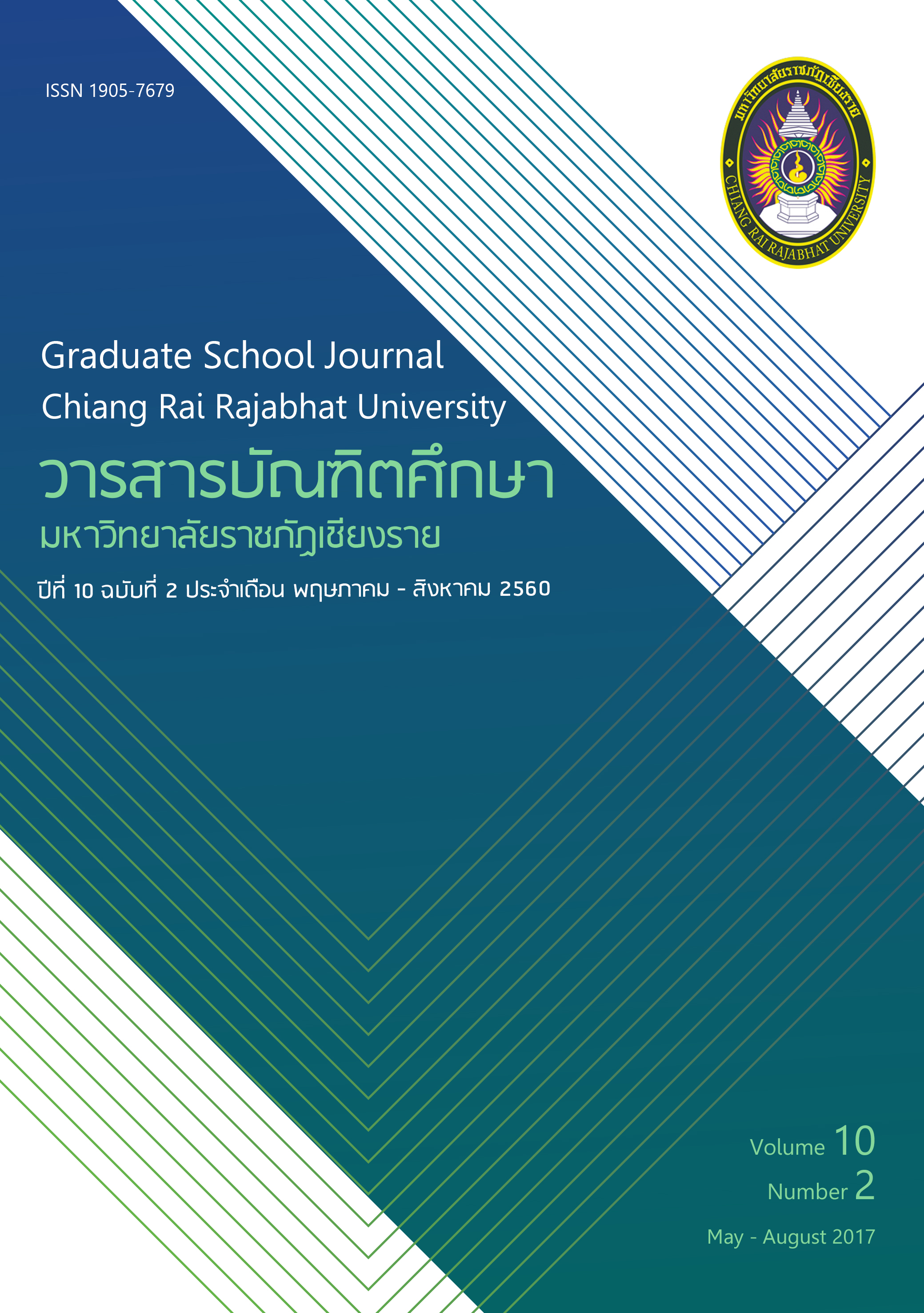การพัฒนาทักษะด้านการเขียนของเด็กปฐมวัยโดยใช้สื่อตามแนวคิดการสอน แบบมอนเตสซอรี ชั้นอนุบาลปีที่ 2 โรงเรียนอนุบาลเวียงชัย สำนักงานเขตพื้นที่การศึกษาประถมศึกษาเชียงราย เขต 1
Main Article Content
บทคัดย่อ
วัตถุประสงค์ของการวิจัยครั้งนี้เพื่อพัฒนาทักษะด้านการเขียนของนักเรียน เพื่อศึกษาความสามารถ
ในการคิดแก้ปัญหาของนักเรียน และเพื่อศึกษาความพึงพอใจของนักเรียนชั้นอนุบาล 2 โรงเรียนอนุบาล
เวียงชัย สำนักงานเขตพื้นที่การศึกษาประถมศึกษาเชียงราย เขต 1 ภาคเรียนที่ 1 ปีการศึกษา 2556 จำนวน
16 คน เครื่องมือที่ใช้ในการวิจัย ได้แก่ แผนการจัดประสบการณ์การเรียนรู้ตามรูปแบบมอนเตสซอรี
ชุดฝึกทักษะด้านการเขียนของเด็กปฐมวัยโดยใช้สื่อตามรูปแบบการสอนแบบมอนเตสซอรี แบบวัดทักษะ
การเขียน และแบบวัดความพึงพอใจของนักเรียนที่มีต่อการเรียนด้วยสื่อตามรูปแบบมอนเตสซอรี ชั้นอนุบาล 2
ผลการวิจัยพบว่า
1. หลังจากการจัดประสบการณ์การพัฒนาทักษะด้านการเขียนของเด็กปฐมวัยโดยใช้สื่อตามแนวคิด
การสอนแบบมอนเตสซอรี ชั้นอนุบาล 2 มีคะแนนเฉลี่ยก่อนการจัดประสบการณ์ ร้อยละ 51.04 และมีคะแนน
เฉลี่ยหลังการจัดประสบการณ์ ร้อยละ 96.66 พบว่า คะแนนเฉลี่ยหลังการจัดประสบการณ์สูงกว่าก่อนได้รับ
การจัดประสบการณ์
2. หลังจากการจัดประสบการณ์คิดแก้ปัญหาจากคะแนนนักเรียนชั้นอนุบาลปีที่ 2 โดยใช้ชุดสื่อ
ตามรูปแบบมอนเตสซอรีที่ส่งเสริมทักษะการเขียน มีคะแนนเฉลี่ยหลังการจัดประสบการณ์สูงกว่าคะแนน
เฉลี่ยก่อนการจัดประสบการณ์
3. หลังจากการจัดประสบการณ์การพัฒนาทักษะด้านการเขียนของเด็กปฐมวัยโดยใช้สื่อตามแนวคิด
การสอนแบบมอนเตสซอรี ชั้นอนุบาล 2 โดยรวมนักเรียนมีความพึงพอใจต่อการจัดประสบการณ์อยู่ในระดับมาก
Article Details
บทความที่ได้รับการตีพิมพ์เป็นลิขสิทธิ์ของวารสารมหาวิทยาลัยราชภัฎเชียงราย
ข้อความที่ปรากฏในบทความแต่ละเรื่องในวารสารวิชาการเล่มนี้เป็นความคิดเห็นส่วนตัวของผู้เขียนแต่ละท่านไม่เกี่ยวข้องกับมหาวิทยาลัยราชภัฎเชียงราย และคณาจารย์ท่านอื่นๆในมหาวิทยาลัยฯ แต่อย่างใด ความรับผิดชอบองค์ประกอบทั้งหมดของบทความแต่ละเรื่องเป็นของผู้เขียนแต่ละท่าน หากมีความผิดพลาดใดๆ ผู้เขียนแต่ละท่านจะรับผิดชอบบทความของตนเองแต่ผู้เดียว
เอกสารอ้างอิง
กระทรวงศึกษาธิการ. (2541). คู่มือการจัดการเรียนการสอนภาษาอังกฤษระดับมัธยมศึกษาตอนต้น
และมัธยมศึกษาตอนปลาย เล่ม 1. กรุงเทพฯ: กระทรวงฯ.
กุลยา ตันติผลาชีวะ. (2543). การสอนแบบจิตปัญญา : แนวการใช้ในการสร้างแผนการสอนแบบ
อนุบาลศึกษา. กรุงเทพฯ: เอดิสันเพรช โปรดักส์.
_______. (2547). กิจกรรมการเรียนรู้สำหรับเด็กปฐมวัย. กรุงเทพฯ: เอดิสันเพรช โปรดักส์.
นพพร ธนะชัยขันธ์. (2555). สถิติเบื้องต้นสำหรับการวิจัย. กรุงเทพฯ: วิทยพัฒน์.
นฤมล เฉียบแหลม. (2545). การศึกษาพัฒนาการด้านการเขียนของเด็กปฐมวัยที่ได้รับการ
จัดประสบการณ์การเรียนรู้ภาษาแบบธรรมชาติ. (วิทยานิพนธ์การศึกษามหาบัณฑิต).
มหาวิทยาลัยศรีนครินทรวิโรฒ ประสานมิตร. กรุงเทพฯ.
ประไพ แสงดา. (2544). ผลการจัดกิจกรรมเสริมการเล่านิทานไม่จบเรื่องที่มีต่อความสามารถด้าน
การเขียนของเด็กปฐมวัน. (วิทยานิพนธ์การศึกษามหาบัณฑิต). มหาวิทยาลัย
ศรีนครินทรวิโรฒ ประสานมิตร. กรุงเทพฯ.
มินดา วงศ์วิชิต. (2543). การศึกษาพฤติกรรมทางสังคมของเด็กอนุบาล : กรณีศึกษาโรงเรียนอนุบาล
ที่ใช้วิธีการของมอนเตสซอรี. กรุงเทพฯ: จุฬาลงกรณ์มหาวิทยาลัย.
สมยศ นาวีการ. (2521). การพัฒนาองค์กรและแรงจูงใจ. กรุงเทพฯ: กรุงสยามการพิมพ์.


